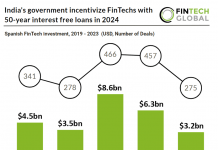Open banking and new technologies have made the marketplace lending FinTech market explode. But where will it go from here?
Nowadays consumers expect streamlined, personalised services and marketplace lending companies are cottoning on. Technology is becoming ingrained into every aspect of our lives and all these touchpoints are creating more data on us. Banks are already leveraging these information streams to improve personal finance offerings, but now lending services are coming into the crosshairs.
Marketplace lending has established itself as one of the biggest segments of the FinTech space. It comes as little surprise to see that lending technology startups continue to attract hefty amounts of capital. In 2019, a total of $12.4bn was invested globally across 279 transactions, up from the previous year where just $7.5bn was deployed across 243 deals. This is not simply a case of more companies raising rounds. In 2019, there were a lot more deals valued over $100m than previous years, showing FinTechs in the space are maturing.
With the emergence and growing use of digital services, consumers are getting used to quicker and easier processes. Gone are the days where people would expect a loan application to take weeks. Instead, they want instant gratification.
This change in mindset has paved the way for technology like artificial intelligence and machine learning. These tools can analyse masses of information and build character profiles at a quicker rate, to give consumers a better experience. Moreover, leveraging more data and technology can help boost financial inclusion. The key to making the most of these solutions is access to as much data as possible, whether its internal or external, and the open banking regulation is pioneering this.
The push for open banking aims to make sharing data between market stakeholders more common.  Introduced in 2018, open banking aims to provide customers with more personalised experiences and products by empowering them to share their data amongst their service providers. It’s incredibly rare for people to be in the same financial situation, so financial products should not be a one-size-fits-all. The introduction of initiatives like open banking are helping these services become much more personalised, assisting people in finding the products right for them or get previously unreachable services. Companies around the world are implementing new open banking standards or services to do just that.
“Increasing access to customer data, through technology such as open banking, for example, is a positive step for the industry,†said Jake Ranson, chief customer officer at loan comparison platform Freedom Finance . “It has also undoubtedly improved the financial inclusion of consumers without access to traditional credit lines. It is those consumers with thinner credit files or irregular incomes, such as the self-employed, people new to the UK or younger borrowers – who are yet to build a comprehensive credit file – who stand to gain the most.â€
Leveraging the new datasets and application programming interfaces (APIs) can accelerate risk assessments and improve decisions for loan. Simon Cureton CEO at Funding Options, a loan comparison service, said, “New marketplace lending technologies combined with open banking are powering both a revolution in commercial lending, as well as a level of financial inclusion far greater than ever before.â€
Yet, not everyone is satisfied with open banking. “The positive effect of open banking on innovation has been nil,†Tom Blomfield, founder and CEO of Monzo, the UK challenger bank, recently said. “I don’t see any businesses based on open banking in Europe whatsoever.†He argued that open banking “is imposing massive costs on [challengers]†like Monzo “to implement standards nobody uses.â€
The market looks like a number of businesses have similar concerns about the regulation. A recent study from Intuit QuickBooks claimed 45% of small businesses could not explain what it was or were confused about it. Moving further, 48% stated they felt it would have no impact on their business.
Problems around open banking may not be as apparent as this depicts, with the Competition and Markets Authority (CMA), the body enforcing the regulation, stating there are over 200 open banking providers in the UK and that more than one million people were using these services. It could just be a matter of patience and time until the full effects of open banking benefits are realised.
Whether its accessing data from banks through APIs or if it is through a traditional partnership, traditional financial institutions might start looking to work with lending startups. Metro Bank recently formed a partnership with Funding Options to enable its customers to compare financing options from over 70 lenders.
Funding Options’ Simon Cureton said, “In my opinion lending-as-a-service (LaaS) has only just started to show its potential to change the lending landscape globally. The challenger banks and AltFi lenders were early adopters. Now we are seeing the incumbent banks take notice of this new technology and several big tech players, such as Amazon and PayPal, have stolen a march on their more traditional counterparts in partnering with LaaS providers to enter and compete in the lending sector.†Banks might be looking more towards the lending technology space, but what type of services may they be looking at?
Where is the future of LendTech?
Traditionally, a lender had to blindly trust what a borrower spent their loan on. When a business or individual received a loan, it was sent straight to their bank account and the originator had no idea if it was spent on what the borrower initially outlined. But those days could be gone.
That is due to the digital ecosystem becoming increasingly connected. Today, companies share more data with one another, lenders can start to keep an eye on their customer and if they are keeping to their promises.
Several modern lenders have issued virtual cards where loans are spent through in-built controls linked to geolocation data. Marqeta is one of the company’s currently leveraging this type of solution. “For example, if a company needs a loan to support an IT refresh, spending controls can manage where the money can be spent – if the borrower is at PC World, then the payment will go through no problem, if they are in Oddbins, it won’t,†Ian Johnson, head of Europe at Marqeta, the modern card issuer, told FinTech Global. By integrating a system like this, lenders can lower their risk and delinquency rates due to money only being supplied when required. It also enables the lender to better understand customers’ spending habits and, in turn, their risk profile.
Besides keeping tabs on spending, these virtual cards can become a new type of point-of-sale loan service. If a customer is about to buy a new TV, instead of going through a traditional application process, they could use the virtual card to get approval in near real-time.
Implementing these virtual cards as a more controlled loan method could go a long way to boost financial inclusion. Johnson believed firms trying to reduce their delinquency rates could become more cautious to issuing loans to high-risk lenders. Whereas, with tighter controls, where funds are only deployed when needed and not for extra unagreed expenses, they allow for more risky borrowers to take out a loan. It also enables a lender to track spending habits a little closer.
The digital world is creating a new wealth of data available to businesses and it just keeps growing. Technology is making digital footprints on customers, which if tapped by a business, enables them much better understandings of their behaviours and habits. While virtual cards will help a business keep track of spending, other pieces of technology are able to track how much people exercise or where they travel to. If a company gets access to all of this information, they can predict how the customer will act and provide them with more personalised services.
Banks, credit unions and other lenders are some of the organisations that could hugely benefit from greater data access. Currently, when applying for a loan, there are often lengthy application procedures with credit checks and endless documents to fill in. However, these arduous loan systems may not be acceptable for much longer in a world of on-demand services and a customer expectation of fast processes. By gaining access to real-time data, a lender can gain more context on the borrower and their financial behaviour removing their reliance on credit histories and reaching decisions quicker.
Understanding customers better looks as if it will be the main driving force of evolution in the lending sector over the coming years. Whether it is through analysing more data sets or keeping closer tabs on spending, building an accurate customer profile will help personalise loan experiences and ensure more people can access credit.
Copyright © 2020 FinTech Global











